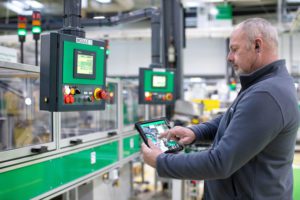Part 3 of the Blog Series: Navigating your digital journey with extended enterprise partners
If you build it, will they come? That is, a new digital business model? Will it attract customers for the long haul in the digital economy?
This is a question every company facing digital transformation is urgently trying to answer. In my recent blog post on AI, I mentioned that creating new digital business models that leverage AI applications, IoT, cloud, and other digital advancements is critical for a company’s successful digital transformation.
The OEM Berto Coffee Roaster has found an answer by fully digitizing and automating its specialized coffee roaster machine, in turn improving its production output, quality, and consistency. In addition to adding value for Berto in the competitive export market (e.g., reduced maintenance time by up to 50%), this EcoStruxure™ Machine Advisor co-innovation work with Schneider, Microsoft, and Berto opens the door for developing new digital business models.
A digital balancing act
Let’s take a closer look at how other companies trying to create a new digital business model can succeed. When you embark on your digital product R&D and innovation strategy, balancing three layers at once is essential:
- Creating connected, intelligent products
- Creating the ways to deliver the product and capture its business value
- Creating an amazing digital customer experience
The digital experience is the glue to parts 1 and 2 and, by extension, your customer-driven business at large. There is no point in delivering the product if the user experience is poor. As IIoT expert at Accenture Jean Cabanes says, “One of the key aspects for creating new digital business models is the way digital companies innovate. Today you need to leverage digital to move from traditional product development to understanding the full digital customer experience. This customer-centric mindset must be embedded in innovation itself.”
Indeed, customers form the foundation upon which every digital business model must be built. From there, three steps advance digital transformation for business growth:
Step 1. Start small and focused
To most businesses, launching a digital journey may feel like boiling the ocean. With so many challenges to tackle, focusing on the “right ones” is critical and often daunting. For example, a hospital customer needed to protect uptime (a must-have) while also optimizing infrastructure maintenance (a nice-to-have). It’s very important to keep in mind that you don’t have to solve every problem at the same time, allowing the “must-haves” to rise to the top of your efforts.
Start small and be very specific. For instance, when we launched a customer-led project to develop a digital power monitoring offer and service, we focused on just critical buildings in the hospital segment in one geographical location. From there, we were able to iterate, by listening to the voice of the customer, before expanding across segments and geographies.
Step 2: Design the business model along with the product
As I said, when we design an offer, we design the business model at the same time. Working directly with our OEM customers, for example, we understood among their top priorities how important it is for them to be able to track, monitor, and maintain their highly specialized machines cost-effectively, addressing:
- How can I track where my machines are going and their customers’ operating context to better monitor risk of failure?
- How do I optimize maintenance costs for a globally widespread fleet of highly specialized and tailored machines?
Then we embarked on solving these challenges. Partnering with OEMs in our R&D cycle, we created a solution around a subscription digital business model with the digital service EcoStruxure™ Machine Advisor. This service enables OEMs not only to track and monitor machines remotely but also to offer an ongoing service subscription to their customers via an “uptime-as-a-service” business model. This approach keeps OEMs from having to send their specialist engineers on the road to maintain or fix machines all over the world.
Step 3: Leverage an ecosystem to scale the model with speed and agility
It’s clear today that no company can transform alone. Leveraging an open ecosystem – extending your enterprise as our CEO Jean-Pascal Tricoire explains in Part 1 of this blog series – is the way to go faster. In fact, it’s essential for seizing digital’s business value while being able to scale innovation more efficiently with each deployment. Co-innovation helps you cut through digital’s complexity and the market’s volatility and changing demands.
We launched a Digital Services Factory to boost innovation. Innovating with customers as part of the process has reduced our time-to-market from the classical 2-3 years, to just one year, delivering both top- and bottom-line value from this collaborative approach.
https://www.youtube.com/watch?v=Bio7D8b_iro
How digitally mature are you?
Every competitive company must become agile and fast to thrive in the digital economy. Digital innovation and our co-innovation ecosystem, which can include the culmination of looking beyond traditional industrial boundaries as our Chief Digital Officer explains in Part 2 of this blog series, allow us to tackle the imperatives for digital transformation. After all, digital transformation is about bringing digital maturity to the core of your business, building on your customer-centric foundation to drive long-term growth.




Conversation
Great insights cyril